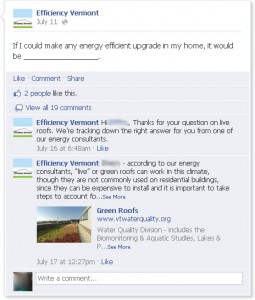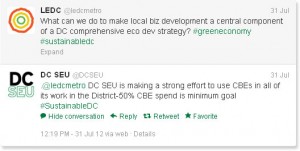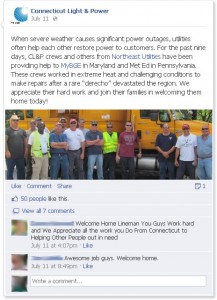By neepenergy | Mon, August 13, 12
 Energy efficiency programs are gaining increasing traction using social media, especially to promote residential retail products. Alison Emerson, Digital Content & Social Media Producer of Efficiency Vermont’s highly successful social media efforts, told NEEP that they are seeing a positive trend using Facebook and Twitter to drive overall brand awareness. Other programs are achieving similar success.
To spread this momentum across the region, we wanted to feature some best practices learned from these “social” leaders in energy efficiency. We send special thanks to Alison Emerson for allowing us to pick her brain for this post, and to all our sponsors using social media—including those not specifically mentioned in this post.
Aim for Engagement
Efficiency Vermont measures success by the percentage of fans and followers who actively engage with them. They found that the frequency of comments, retweets, and “liked” posts better indicate success than the total number of people who “like” their program.
“On Facebook, we’ve had success with asking questions,” Alison said. After posting, she spends time “monitoring the responses (or lack of responses) and adjusting for the next time around.” Keeping a content calendar allows her to create and tweak content before she needs it.
Mass Save also gets creative to encourage engagement on Facebook. Examples like weekly word scrambles, questions about Advanced Power Strips, and group-buying promotions for residential lighting products all gained comments and “likes”.
Energy efficiency programs are gaining increasing traction using social media, especially to promote residential retail products. Alison Emerson, Digital Content & Social Media Producer of Efficiency Vermont’s highly successful social media efforts, told NEEP that they are seeing a positive trend using Facebook and Twitter to drive overall brand awareness. Other programs are achieving similar success.
To spread this momentum across the region, we wanted to feature some best practices learned from these “social” leaders in energy efficiency. We send special thanks to Alison Emerson for allowing us to pick her brain for this post, and to all our sponsors using social media—including those not specifically mentioned in this post.
Aim for Engagement
Efficiency Vermont measures success by the percentage of fans and followers who actively engage with them. They found that the frequency of comments, retweets, and “liked” posts better indicate success than the total number of people who “like” their program.
“On Facebook, we’ve had success with asking questions,” Alison said. After posting, she spends time “monitoring the responses (or lack of responses) and adjusting for the next time around.” Keeping a content calendar allows her to create and tweak content before she needs it.
Mass Save also gets creative to encourage engagement on Facebook. Examples like weekly word scrambles, questions about Advanced Power Strips, and group-buying promotions for residential lighting products all gained comments and “likes”.
 Engagement can also go beyond customers; the District of Columbia Sustainable Energy Utility interacts with other community organizations via Facebook and Twitter to bring collaboration online.
Make Educated Posts
Alison’s experience: “I do a lot of research on what is working for other brands on social media and if I feel like it will resonate with our customers, I give it a try.” A lot of Alison’s inspiration for Efficiency Vermont’s social media work comes from outside the energy efficiency world.
Efficiency Vermont’s social media started small and grew slowly. After three years, Alison felt confident enough in her content that she launched a Vermont-targeted Facebook ad campaign in July.
NYSERDA’s Facebook page often features local events and programs that would interest specific customers, such as contractors, low-income families, or renters. In another great example of content aimed at reaching out to its customers, a recent DCSEU post included photos from an event that featured many people outside of the organization.
Create Emotional Connections
Customers use social media to connect with people and things they care about, so transforming energy efficiency facts and info into something that connects emotionally is important. “No one is going to waste time they could be playing Angry Birds to look at your Facebook page unless it holds a high value for them,” Alison put it bluntly. “Finding value and creating content to show it off is challenging but ultimately rewarding if it means greater brand awareness and positive customer engagement.”
A July post by Efficiency Vermont asked customers: “If I could make any energy efficient upgrade in my home, it would be _________________.” That question seemed to resonate with people; it gained 19 comments and 7 “likes.”
Several NEEP sponsors also u
Engagement can also go beyond customers; the District of Columbia Sustainable Energy Utility interacts with other community organizations via Facebook and Twitter to bring collaboration online.
Make Educated Posts
Alison’s experience: “I do a lot of research on what is working for other brands on social media and if I feel like it will resonate with our customers, I give it a try.” A lot of Alison’s inspiration for Efficiency Vermont’s social media work comes from outside the energy efficiency world.
Efficiency Vermont’s social media started small and grew slowly. After three years, Alison felt confident enough in her content that she launched a Vermont-targeted Facebook ad campaign in July.
NYSERDA’s Facebook page often features local events and programs that would interest specific customers, such as contractors, low-income families, or renters. In another great example of content aimed at reaching out to its customers, a recent DCSEU post included photos from an event that featured many people outside of the organization.
Create Emotional Connections
Customers use social media to connect with people and things they care about, so transforming energy efficiency facts and info into something that connects emotionally is important. “No one is going to waste time they could be playing Angry Birds to look at your Facebook page unless it holds a high value for them,” Alison put it bluntly. “Finding value and creating content to show it off is challenging but ultimately rewarding if it means greater brand awareness and positive customer engagement.”
A July post by Efficiency Vermont asked customers: “If I could make any energy efficient upgrade in my home, it would be _________________.” That question seemed to resonate with people; it gained 19 comments and 7 “likes.”
Several NEEP sponsors also u se social media as an outreach tool during power outages or emergency situations. Connecticut Light & Power, for example, has a two-way relationship with almost 10,000 Facebook users. Beyond sending and responding to storm warnings and disasters, CL&P creates emotional ties between its customers and employees. A recent post about CL&P crews travelling to Pennsylvania to restore power after severe storms gained several “Welcome Home” comments and 50 “likes.”
Go Social!
Regardless of the status of your current social media efforts, these organizations provide excellent examples to learn from. Social media is a fast-moving (and sometimes daunting) communications channel that fundamentally changes the way we interact, and it’s here to stay. By embracing Facebook, Twitter, and other powerful social technologies you can learn how to use social media to drive energy savings and continue leading the Northeast into an energy efficient future.
se social media as an outreach tool during power outages or emergency situations. Connecticut Light & Power, for example, has a two-way relationship with almost 10,000 Facebook users. Beyond sending and responding to storm warnings and disasters, CL&P creates emotional ties between its customers and employees. A recent post about CL&P crews travelling to Pennsylvania to restore power after severe storms gained several “Welcome Home” comments and 50 “likes.”
Go Social!
Regardless of the status of your current social media efforts, these organizations provide excellent examples to learn from. Social media is a fast-moving (and sometimes daunting) communications channel that fundamentally changes the way we interact, and it’s here to stay. By embracing Facebook, Twitter, and other powerful social technologies you can learn how to use social media to drive energy savings and continue leading the Northeast into an energy efficient future.